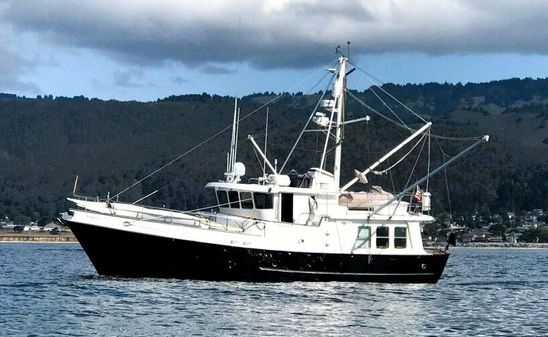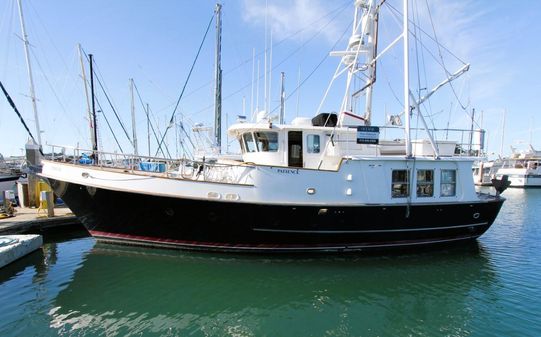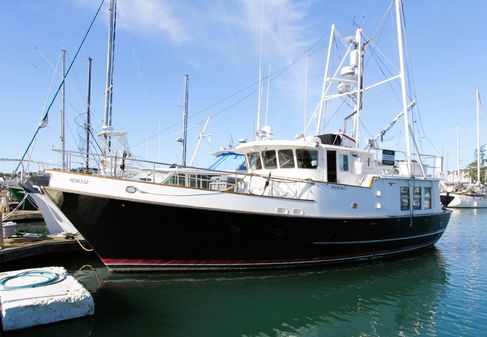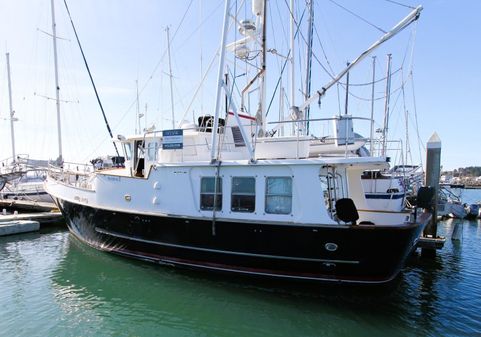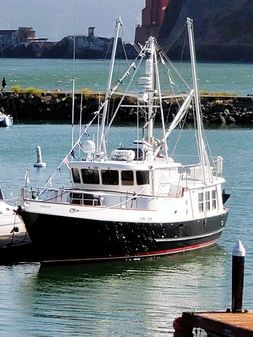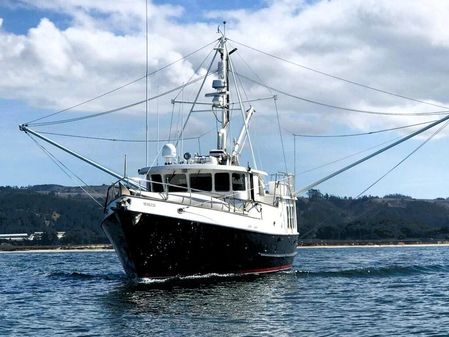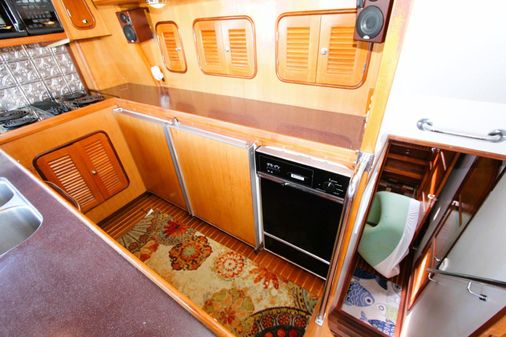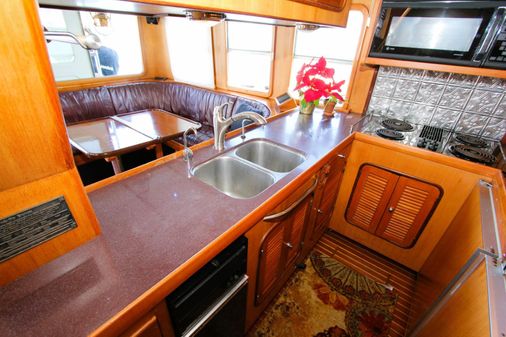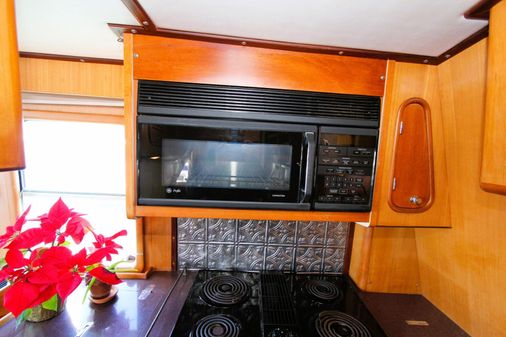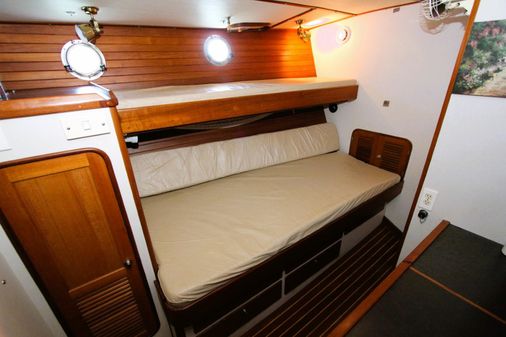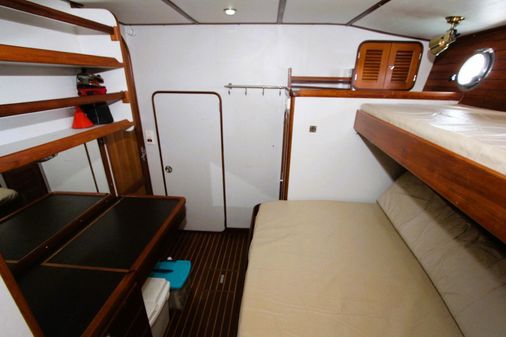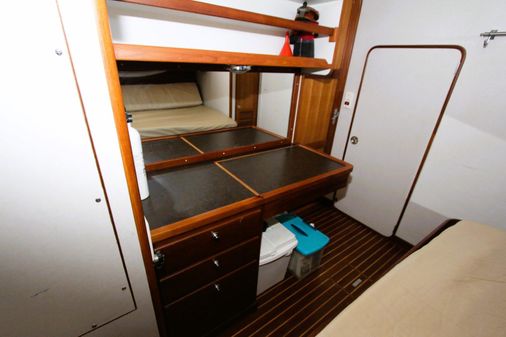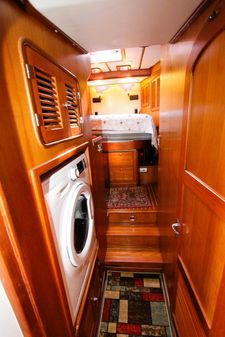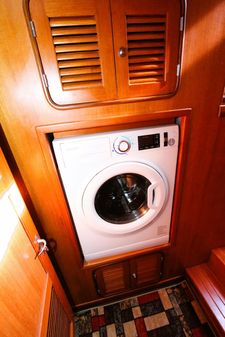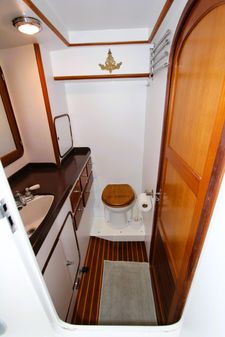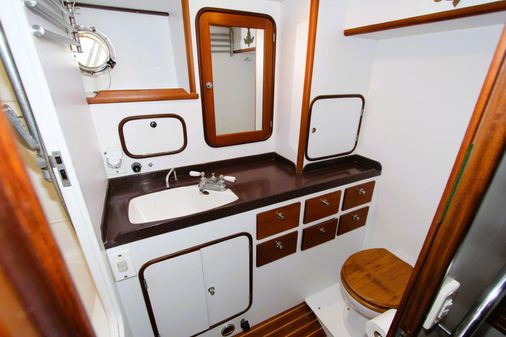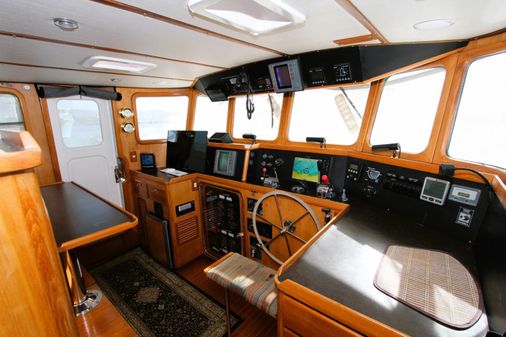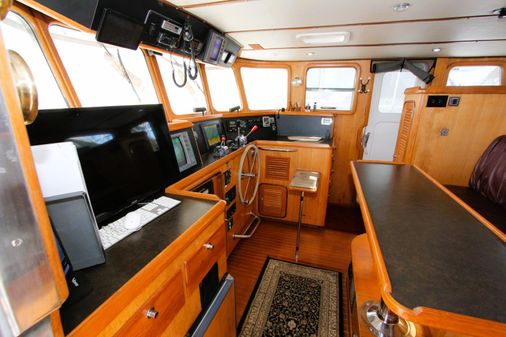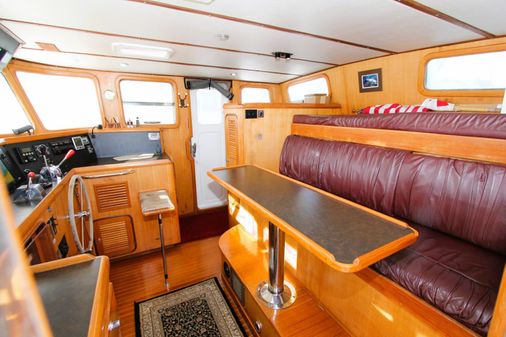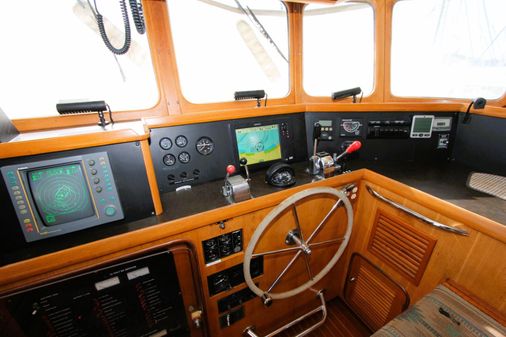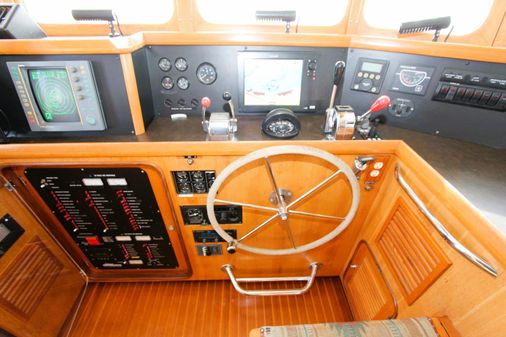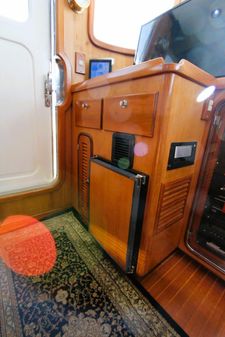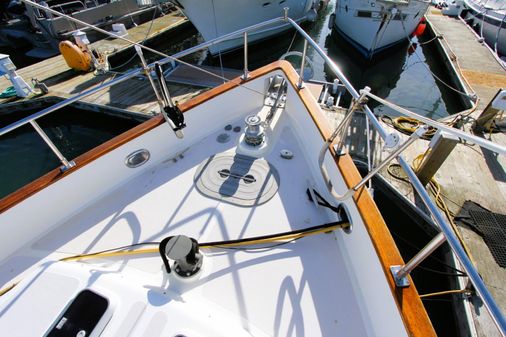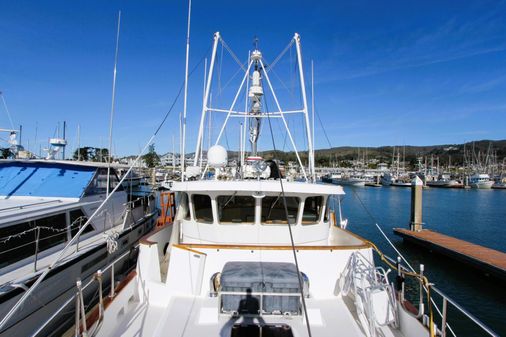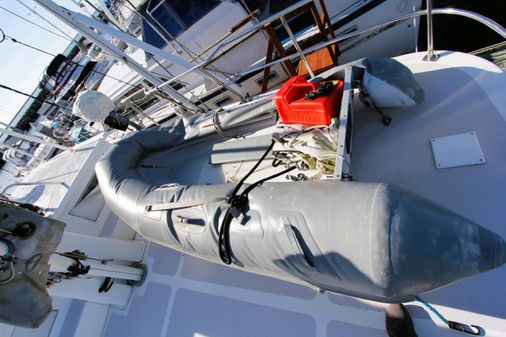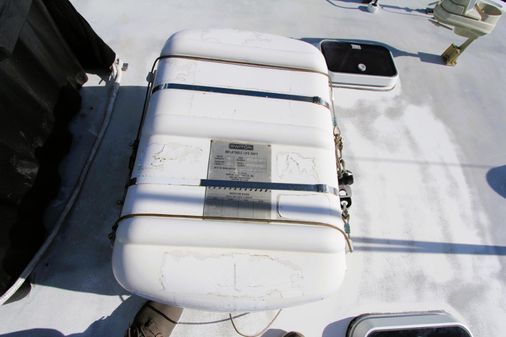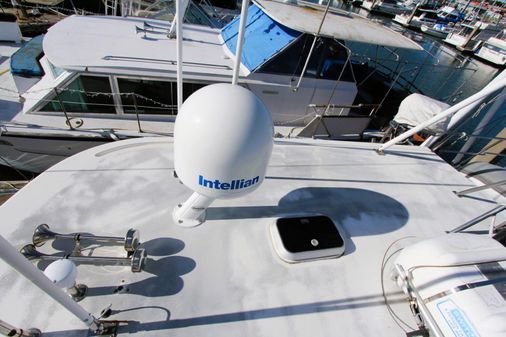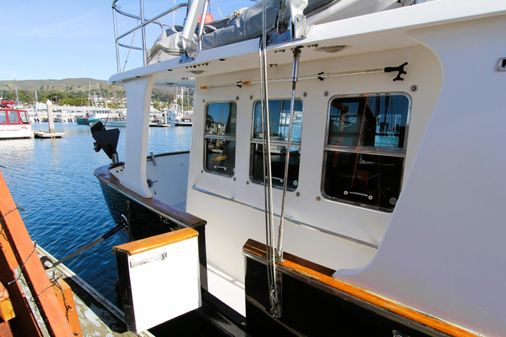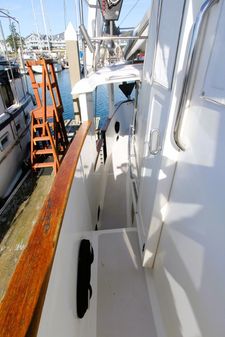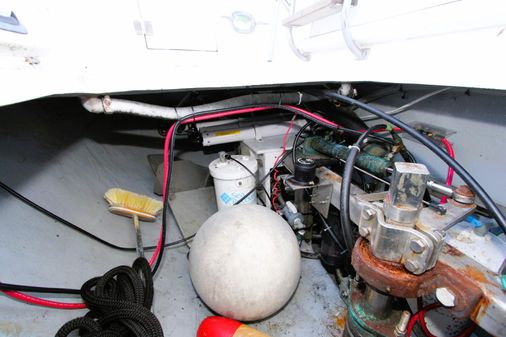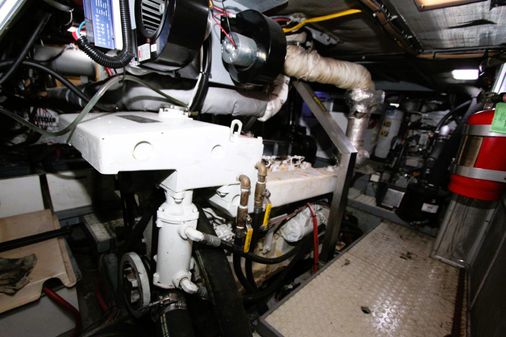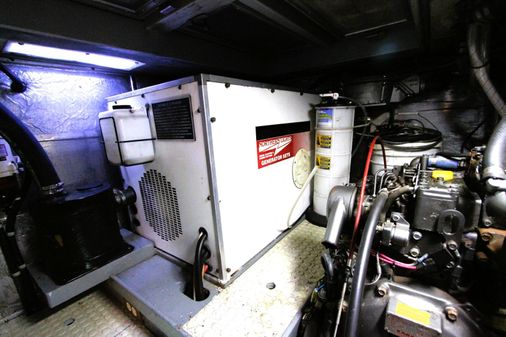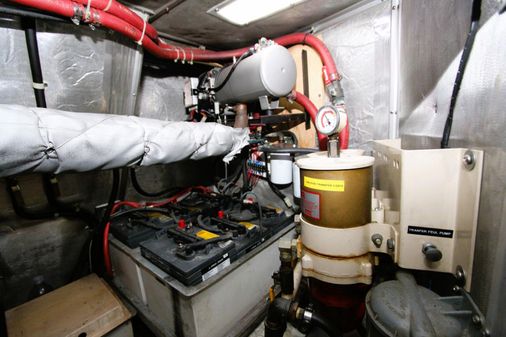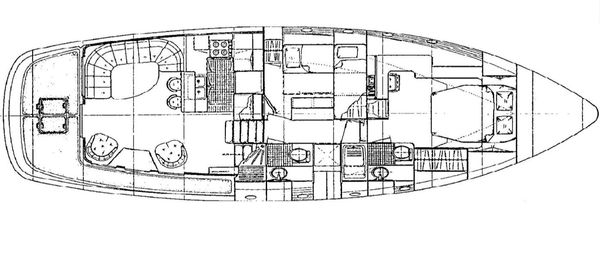Basic Boat Info
Dimensions
Engines / Speed
- Make: Lugger L668D
- Model: Lugger L668D
- Fuel: Diesel
- Engine Power: 140hp
- Type: Inboard
- Propeller Type: 4 BladeBronze
- Engine Location: Center
- Drive Type: Direct
- Year: 1995
- Engine Hours: 8,143
- Make: Yanmar, Wing Engine
- Model: 3GM30-93
- Fuel: Diesel
- Engine Power: 27hp
- Type: Inboard
- Propeller Type: 3 BladeBronze, Folding
- Drive Type: Direct
- Engine Hours: 100
Tanks
Other
Contact
Office
308 Harbor Drive
Sausalito, CA, US, 94965
Tel:415-377-0866
The Company offers the details of this vessel in good faith but cannot guarantee or warrant the accuracy of this information nor warrant the condition of the vessel. A buyer should instruct his agents, or his surveyors, to investigate such details as the buyer desires validated. This vessel is offered subject to prior sale, price change, or withdrawal without notice.
The Nordhavn 46 is the result of years of experience and research done in recognition of the need for a yacht possessing world cruising capability that is manageable by today's cruising couple. The 46-foot Long Range Cruiser offers a combination of technical features, luxury accommodations, overall performance, and aesthetic appeal. This vessel will travel comfortably, quietly, reliably, and safely at 8.5 knots for up to 3,000 miles. P.A.E. Yacht Builders in Dana Point have built a solid reputation for designing and producing MASON series sailboats. The Nordhavn 46 is a serious offshore powerboat designed for the sailor who desires the advantages of a power boat. Underway, the aft deck is quiet and exhaust-free (just like sailing). The displacement hull, with its gracefully designed transom, creates a minimum wake at cruising speed. The dry exhaust eliminates diesel smoke and noise, and the 30-foot propeller, driven through a three-to-one reduction, minimizes the vibration and cavitation noise. The aft salon and wheel house doors may be left open without sucking the exhaust gas into the salon. The large main salon leaves room for a passageway on the starboard side. The port side provides space for handling dock - spring lines, and transom-type doors on both the port side and the starboard side provide easy boarding. A Portuguese bridge wraps completely around the wheelhouse, and a door in the bridge coaming allows easy access to the foredeck. The entire deck area is finished with a non-skid raised molded diamond pattern. There is adequate room on the boat deck for a large inflatable rigid tender. The yacht's boom or an optional davit can raise and lower the dingy. The spar can accommodate instrumentation, antennas, radar, and a steadying sail. Access from the aft deck is provided by a ladder. The wheelhouse is located amidships where the pitching motion of the yacht is felt least, a detail that is important in offshore conditions. The position of the wheelhouse combined with the forward angle of the windows, Portuguese bridge coaming, and high bows make storm damage highly unlikely. The offwatch partner can sleep within reaching distance of the person on watch, which is particularly important on a couple-crewed yacht. The settee back folds up making the single-watch bunk into a comfortable double berth. The wheelhouse is an excellent place to dine, as it offers a panoramic view and cross-ventilation through open windows and doors. The owner's stateroom is amidships to minimize motion, and the noise level is very low. The heavy, sound insulated, structural bulkhead separates the stateroom from the engine room. Plenty of natural ventilation is provided through four opening hull ports and on deck, dorade-type vents. Included are queen-size berth, vanity, and two large hanging lockers (one under steps). The guest stateroom features a large double-berth, with an opposing settee - single-berth. The stateroom has excellent ventilation, a separate head with stall shower, spacious hanging lockers, and is separated from the owner's stateroom with solid structural bulkheads. The main salon's open and airy living area measures eleven feet by twelve feet, offering room for a wood-burning fireplace, and an L-shaped settee and two easy chairs provide seating for six. Opening marine windows provide ventilation, light and a view of the yacht's surroundings, and the partially shaded after deck is accessed through a large sliding door. Out of the main stream of salon traffic, the efficiently designed galley has abundant storage and counter space. Room is provided for a microwave oven and trash compactor, and there is an abundance of natural light and ventilation. The engine room is accessed via a floor hatch or through a walk-in door in the aft head compartment. Numerous large hatches are provided within the main salon solely for major repair or removal of equipment, and a small hatch and ladder are provided when access through the head compartment is impractical. There's partial head room within the engine compartment and space is provided for easy maintenance of engine(s), generator, and the ship's machinery. Producing an ocean-going yacht with unlimited range necessitates the full displacement hull. There is no way to get the combination of range, seakindly motion, structural integrity, and load-carrying capability, and still have a planing hull. While semi-displacement hulls are capable of higher speeds with horsepower, they also require significantly more horsepower at low speeds. This higher power requirement consumes more fuel, requires larger engines, and generates more noise and vibration. The pitching motion of the displacement hull is much softer than that of the semi-planing hull. The deep entry of the displacement hull eliminates pounding, and the easier entry and increased weight cause less deceleration and acceleration as the vessel passes through head seas. Running off the wind, the displacement hull with its full-length keel and large attached rudders offers better directional control and is easier to handle for helmsman or autopilot. The true displacement hull provides maximum stability, seakindliness, and economy. Hull shape plays a large part in steering performance. Any vessel designed to run at speed length ratio of over 1.6 must rely upon lift to semi-plane over the water. A broad, flat transom is required to generate this dynamic lift. Characteristically, this type vessel steers badly with the seas on the quarter or astern. The Nordhavn's full-displacement hull, designed to run at an S-L of 1.34, does not need the dynamic lift and therefore has a properly designed stern for down wind running. Even equipped with twins, it handles better than the semi-displacement vessel. A single 143-hp engine provides plenty of power and allows a cruising range of 3,000 nautical miles with 1,000 gallons of fuel. The single configuration is beneficial for several reasons. The large, slow-turning single propeller is completely protected from floating debris within the propeller aperture and will not make contact with the ocean bottom in the event of an unintentional grounding. In a twin engine application, not only are the propellers vulnerable, but the propeller shafts, shaft struts and, more importantly, the rudders are in equal danger. Almost all modern vessels used in the world's fisheries have single propulsion engines, and those that have two engines generally drive one propeller shaft. A 46.8-horsepower propeller drives this hull to a speed of 8.3 knots (9 knots is possible with some sacrifice in range). Having the large rudder directly behind the propeller and full length keel causes the vessel to steer more easily under adverse conditions. A common complaint among twin engine, semi-displacement, flat-transomed hulls, is the difficulty in maintaining directional control while running off the wind. This causes fatigue for the helmsman, excessive wear and tear for autopilot and steering gear, and an uncomfortable ride. In a single engine application, the engine can be located in the lowest possible hull position and, therefore, the shaft angle from the engine to the propeller can be minimized. Ideally, the thrust should be as close to perpendicular as possible to the vessel's waterline. In other words, a completely horizontal shaft line is best. In a twin engine application the engines must be moved outboard, not in the lowest part of the hull. The props must be located as deep as possible so there is no choice but to increase shaft angle. The loss of efficiency in a twin engine installation is due to the drag of two rudders, along with two propeller shafts and shaft struts, the greater slip of the two smaller propellers, the mechanical inefficiency of two smaller engines and their respective transmissions, and the increased shaft angles of each engine. In a single engine configuration the rudder lies directly behind the keel and when it is not deflected during a course correction, it adds very little additional drag. Twin engines can easily be provided. A 27-hp Sailboat diesel auxiliary driving a separate shaft with a folding propeller (an attractive alternative to twin engines) can be installed alongside the main engine. This auxiliary can provide up to 6 knots of headway. The auxiliary can be fitted with high-output alternators, A.C. generators, or refer compressors to further justify its installation. An electric or hydraulic bow thruster is available for additional maneuverability. With a displacement hull, twin engines are requested for only two reasons: reliability and low-speed docking maneuverability. In lieu of twins, a combination of a bow thruster and wing engine are recommended. With this combination, the vessel's seakeeping qualities are not compromised, and greater maneuverability and reliability will be achieved than with the typical twin engine configuration. NORDHAVN DESIGN COMMENTS: 1. Displacement - Length Ratio (D-L) is a useful tool in comparing the relative weights of different size vessels. As noted by the renowned naval architect, R. Beebe, a vessel around 50-feet LOA with a displacement length ratio under 270 would not be suitable for a true ocean crossing vessel. A vessel with a D-L below 270 would have a hard time carrying the fuel and supplies needed for a long range trip, and would not offer a motion at sea tolerable for a long passage. The D-L of the Nordhavn is 383, heavy by yacht standards, but a D-L in excess of 450 is considered normal for a true fishing trawler. The 383 D-L is a result of the Nordhavn's 8,000 pounds of ballast, heavy construction scantlings, and large fluid capacities. This D-L ratio results in a seakindly motion and load carrying capability. The addition of 2,021 pounds results in a submersion of only one inch if the load is evenly distributed. 2. The Above Water - Below Water Ratio (A-B ratio) is the side-view ratio of area of the vessel above water to that below water. With the demand for luxurious accommodations and the cost per pound of building yachts, the A-B ratio can get beyond acceptable limits for the ocean cruising vessel. An A-B ratio between 2.1 and 2.6 is proper for this type of yacht with a ratio as low as possible preferred. The Nordhavn has an A-B ratio of 2.3. 3. The prismatic coefficient and speed - length ratio should be viewed together. The prismatic coefficient is a comparison of the actual volume of the hull below the waterline in cubic feet to what the volume would be if the body were a 'prism' composed of the largest section from the lines carried the full length of the waterline. The designer will massage the lines of his design to develop the prismatic coefficient that best matches the desired speed - length ratio of the vessel. In a full displacement hull the maximum efficient speed - length ratio is 1.34. This figure represents 1.34 x the square root of the waterline. If a vessel is designed with maximum range as a goal, without regard to speed, the designer would probably select a prismatic coefficient which would match up with a lower speed - length ratio. The prismatic coefficient selected for the Nordhavn is 63 which matches up with the maximum speed - length ratio of 1.34. This means the Nordhavn is designed to run most efficiently at 8.3 knots. 4. Due to a combination of form and ballast stability, the Nordhavn has the ability to right itself in the most severe conditions. Approximately 68,000 foot pounds is required to heel the Nordhavn 30 degrees, 92,000 foot pounds for 60 degrees, and 56,000 foot pounds for 150 degrees. 120 degrees is the target for positive stability as adopted by the USYRU for offshore sailing yachts. The Nordhavn beats this target by another 30 degrees.
Lugger L668D, 140 hp Single Engine, 8142 hours
Top speed of boat: 10.35 mph
Yanmar 3GM30-93 Wing Engine, approximately 100 hours
- Northern Lights 8 kW Generator with 2608 hours, in Sound Box, (non operational, have repair estimate)
- Balmar Marine High-Output 260 Amp Alternator
- Balmar Max Charge Digital Multi-Stage Voltage Regulator
- Battery Switches, Combination solenoid, isolator and cabling
- 10) CAT deep cycle 230 Amp 6 volt batteries house bank
- 1) 8-D start Battery
- OutBack VFX 2814M 2800 watt Inverter and 30 amp battery charger with remote panel
- Lewco 12 volt 80 amp battery charger, with remote panel in Pilothouse
- Amp Hour meter display in Pilothouse
- 2) 50 amp shorepower inlets (AC system separate from house inlet)
- 50 Amp shore power cord
- 30 Amp shore power cord
The Galley is designed for convenience and function, the U-shape galley layout offers easy access, cabinet space, stainless steel hand holds and stove top pot fiddle rails for safe cooking at sea.
- Corian counter tops
- Double stainless steel sinks with deep bowls
- Updated stainless freshwater pressurized fixture
- Full louvers on locking doors
- Locking drawers
- Overhead lockable cabinets
- Teak and spruce floor
- Jenn-Air four burner electric cooktop
- Sub-Zero below counter refrigerator
- Sub-Zero below counter freezer with Icemaker
- GE Profile convection oven and microwave
- Frigidaire dishwasher
- GE trash compactor
- Freshwater and seawater foot pump and spigot at sink
- Seagull water purifier spigot mounted at galley sink (in-board)
- U-line mini refrigerator in Pilothouse
- Magma propane BBQ grill in cockpit
The salon has an L-shaped dinette settee and high/low table which easily converts and slides into position as a full size dining table. A long longitudinal settee to starboard provides additional storage and may be used as a sea berth. The settee cushions are upholstered in beautifully maintained durable leather with many years of additional wear remaining.
- 6 opening windows for great ventilation
- 16,500 btu Marine air conditioner with insolated ducting, fixed and remote controls (needs servicing)
- Dinette table-hinged foldout leaf, hi-lo stainless steel pedestal with a slide for positioning
- Teak and spruce floor
- Leather settee upholstery
- Window blinds and bug screens
- Decorative and functional classic hanging trawler oil lamp
- Bose speakers
- Diesel Heater (needs servicing)
- Table lamp
- Trawler mast and boom with electric winches (2) for tender launching and paravane management (remote switching added to each side of the cockpit for easy retrieval of the stabilizing birds)
- Maxwell 3500 electric anchor windlass (pulled and serviced and installed new floor switches 2014)
- 73 lb Rocna primary anchor with 400' of 3/8" BBB anchor chain re-galvanized in 2009
- Danforth Hi-Tensile galvanized steel anchor with 300' of rope and chain rode
- Steadying sail
- Upper deck halogen floodlight
- Fiberglass fixed mounted deck stowage box
- Custom covered storage box with custom aluminum mounting rack on foredeck
- Fixed aft upper deck ladder (stainless and teak)
- Custom mast forestay
- Access portals aft transom (new)
- Avon 10' hard-bottom RIB with 6 hp Yamaha 4-Stroke outboard (new 2021) added stainless flush mounts and ratchet straps for securing - related equipment (tank, two fuel lines, anchor and etc.) included
Matching double braided dock lines (new 2024) w/ many spares on board for extreme conditions
Magma S/S barbecue
Rotating Spot Light on Pilothouse Roof (new 2019)
- Simrad NNS-12 Easy Touch in dash Touchscreen multifunction display with GPS
- Simrad pole roof mounted high speed GS15 Directional GPS
- Simrad broadband 3G 36 mile Radar
- Simrad GoFree WiFi (Allows access/use of the primary screen anywhere on board)
- ICOM 40 watt 40HM PA/Hailer
- Navionics Platinum+ nautical Charts w/Satellite overlay/3D options of North, Central and South Americas
- ICOM M604A Class D w/DSC VHF Marine Transceiver
- Si-Tex Class B AIS Transceiver
- Iridium Satellite Phone with external high-output antennae
- ICOM IC-7000 HF/VHF/UHF (SSB/Ham Radio
- Pracor SCS Pro model used with SSB to send and receive email, via provider
- Raytheon R41-48 Radar with open array and ARPA capability
- Garmin GPS Antenna
- Argonaut TFlex high vis daylight computer monitor screen
- Simrad/Robertson AP300x autopilot
- Robertson R135 Rudder Angle indicator
- Raytheon V850 Video Depth sounder and Fish Finder
- B&G/Simrad Wind direction and speed meter
- B&G/Simrad Quad display network
The Company offers the details of this vessel in good faith but cannot guarantee or warrant the accuracy of this information nor warrant the condition of the vessel. A buyer should instruct his agents, or his surveyors, to investigate such details as the buyer desires validated. This vessel is offered subject to prior sale, price change, or withdrawal without notice.


